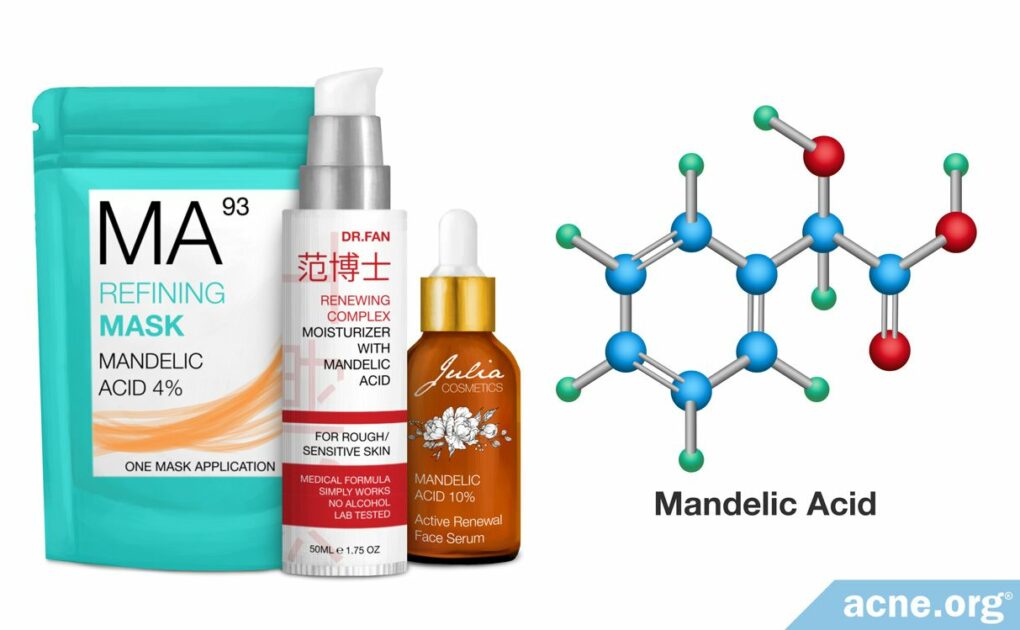Mandelic Acid Exfoliates the Skin, Decreases Skin Oil, Reduces Bacteria, Decreases Hyperpigmentation, and Promotes the Penetration of Acne Medications

The Essential Info
Mandelic acid is an alpha hydroxy acid (AHA), which is applied topically and may help reduce acne to a modest degree by:
- Exfoliating the topmost layer of skin, which keeps pores unclogged
- Reducing bacteria
- Reducing skin oil production
- Decreasing hyperpigmentation (red/dark marks left behind after an acne lesion heals)
- Promoting the penetration of acne medications
- (unrelated to acne) Reducing the signs of skin aging
What is unique about mandelic acid is that it penetrates less deeply into the skin compared with other AHAs, and is thus gentler. However, we will need more research to determine whether it works as well at clearing acne compared to other AHAs.
Like any other AHA (e.g. glycolic acid), mandelic acid will not completely clear acne on its own and should be combined with other medications, like benzoyl peroxide, for best results.

The Science
- Introduction to Mandelic Acid
- How Mandelic Acid Works to Clear Acne
- Mandelic Acid Side Effects
- Efficacy of Mandelic Acid
Introduction to Mandelic Acid
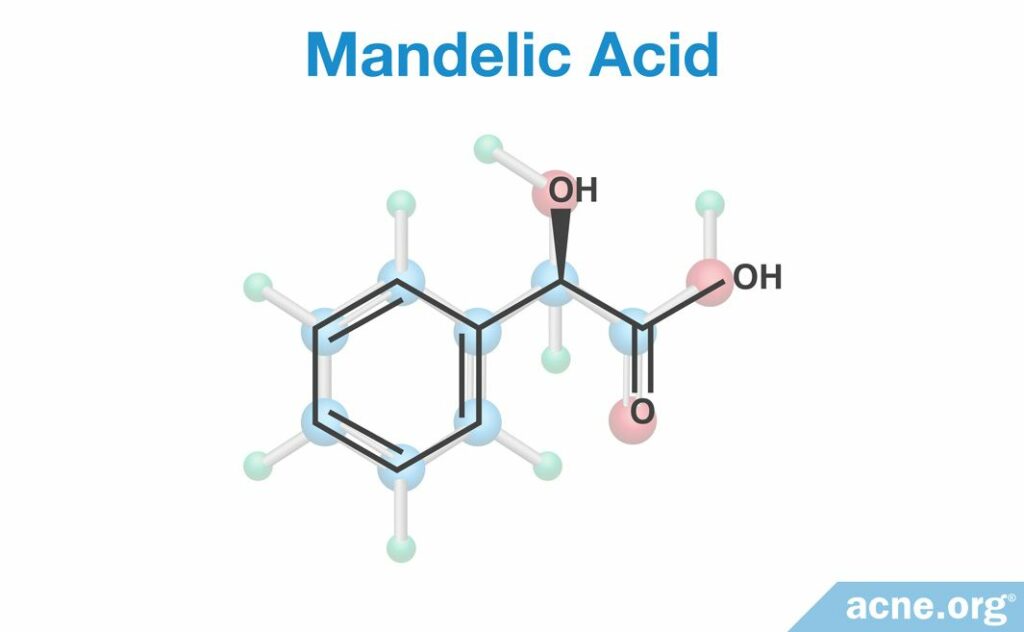
Mandelic acid is an alpha hydroxy acid (AHA), an acid that can be used to treat a variety of skin conditions, including acne.
Mandelic acid is a less common acne treatment. However, it is often found in skin care products because it has antibacterial properties and can help restore proper skin pigmentation.
Scientists have performed little research investigating the effectiveness of mandelic acid to treat acne, but because it is an AHA, it likely works to reduce acne in the same way as other AHAs, like glycolic acid or lactic acid.
Since AHAs are generally not able to clear acne completely on their own, mandelic acid would likely work best in combination with established acne treatments.1
How Mandelic Acid Works to Clear Acne
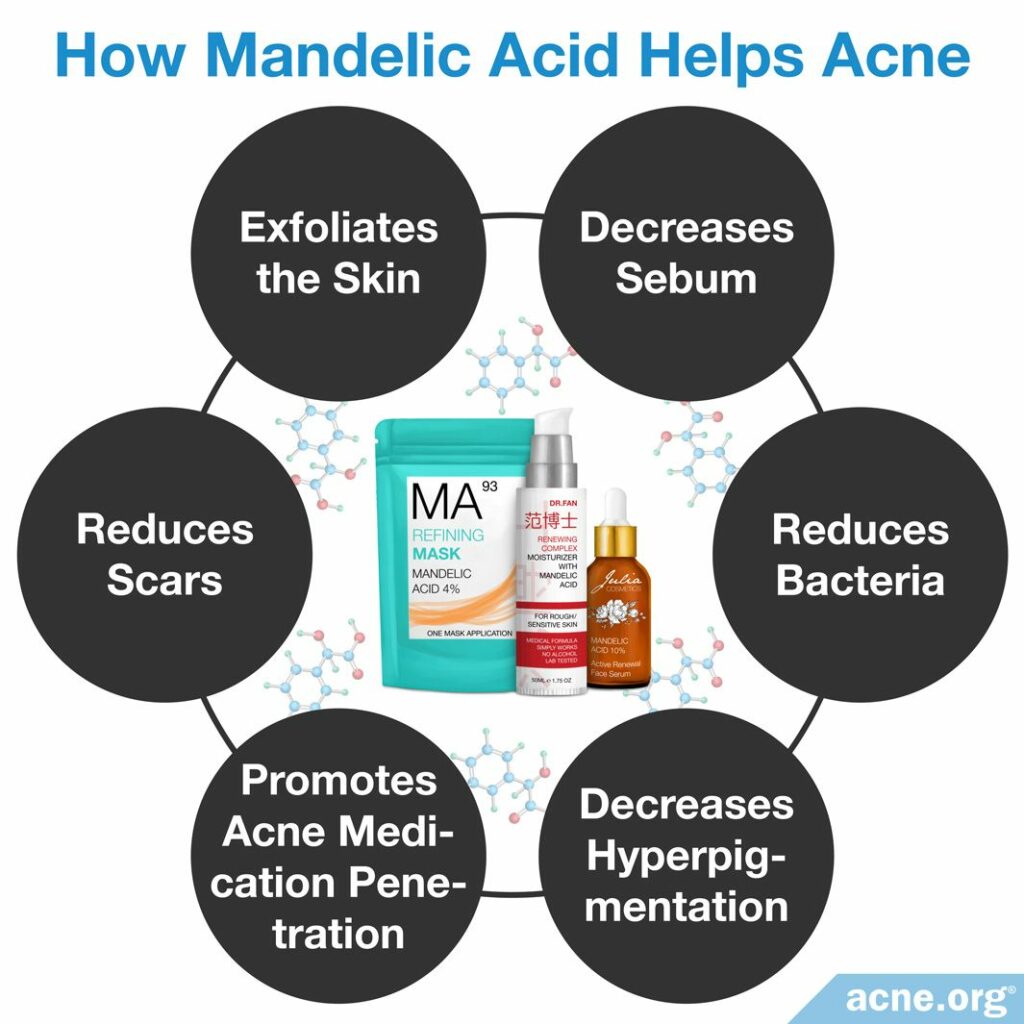
Mandelic acid has several effects on acne and aging skin.
Effects on acne
- Exfoliates the skin: The accumulation of dead skin cells on the surface of the skin leads to clogged pores and acne. Exfoliation of the skin can reduce the number of accumulated dead skin cells, which helps to unclog pores and prevent acne. Mandelic acid works to exfoliate the skin by:
- Absorbing calcium: Mandelic acid can bind to calcium particles. Calcium is an important mineral that attaches onto the surface of skin cells and helps the cells to attach to other skin cells. Mandelic acid captures this calcium, which means that the calcium is not available to bind to skin cells. This causes the connections between skin cells to become weaker, and this helps to exfoliate the skin.
- Breaking down skin cells: Skin cells called keratinocytes produce a sticky protein called keratin. Keratin causes skin cells to stick together like glue, and this results in the accumulation of skin cells on the surface of the skin. Acne-prone individuals often have more keratinocytes than non-acne-prone individuals, and this leads to more keratin and thus more clogged pores and acne. Mandelic acid can degrade keratin and “pull apart” skin cells that are stuck together, and this helps clear the accumulated dead cells from the surface of the skin.
- Breaking down surface skin cells: Corneocytes are skin cells that make up the topmost layer of skin, called the stratum corneum. Mandelic acid promotes the breakdown of corneocytes, and therefore promotes the exfoliation of the stratum corneum. Removing the corneocytes helps to thin the layer of accumulated dead skin cells, resulting in fewer clogged pores and less acne.
- Decreases skin oil: Healthy skin produces skin oil, called sebum. Sebum helps to keep the skin healthy and protected. Acne-prone individuals often produce too much sebum, which accumulates inside of a clogged pore and leads to acne. Mandelic acid can decrease the amount of sebum the skin produces, which helps to prevent the formation of comedones (whiteheads and blackheads).
- Reduces bacteria: A type of bacteria called C. acnes can rapidly grow inside an acne lesion. This type of bacteria makes acne worse by recruiting inflammation that can make the lesion red, swollen, and sore. This type of bacteria also triggers the creation of pus. Mandelic acid has antibacterial properties, meaning that it can decrease the amount of C. acnes inside clogged pores.
- Promotes penetration of acne medications: To be effective at clearing acne, topical acne medications like benzoyl peroxide need to penetrate into the skin. A layer of accumulated dead skin cells covering the skin’s surface can prevent medications from penetrating into the skin, which reduces their effectiveness. Mandelic acid exfoliates the topmost layer of skin, and this allows for topical acne medications to penetrate into the skin more easily, improving their effectiveness.
- Decreases hyperpigmentation: After an acne lesion heals, it may leave behind red/dark marks. Dermatologists call these marks post-inflammatory hyperpigmentation, or just hyperpigmentation for short. Hyperpigmentation is more commonly found in people with non-Caucasian skin. Mandelic acid can decrease hyperpigmentation by promoting the growth of new skin cells. Skin discoloration decreases because new skin cells rapidly replace the old, discolored cells, which evens out the color of the skin.
- Reduces scars: Severe acne lesions may leave scars on the skin. High-percentage mandelic acid peels can reduce scarring from acne lesions to a minor degree.1,2
Anti-aging effects:
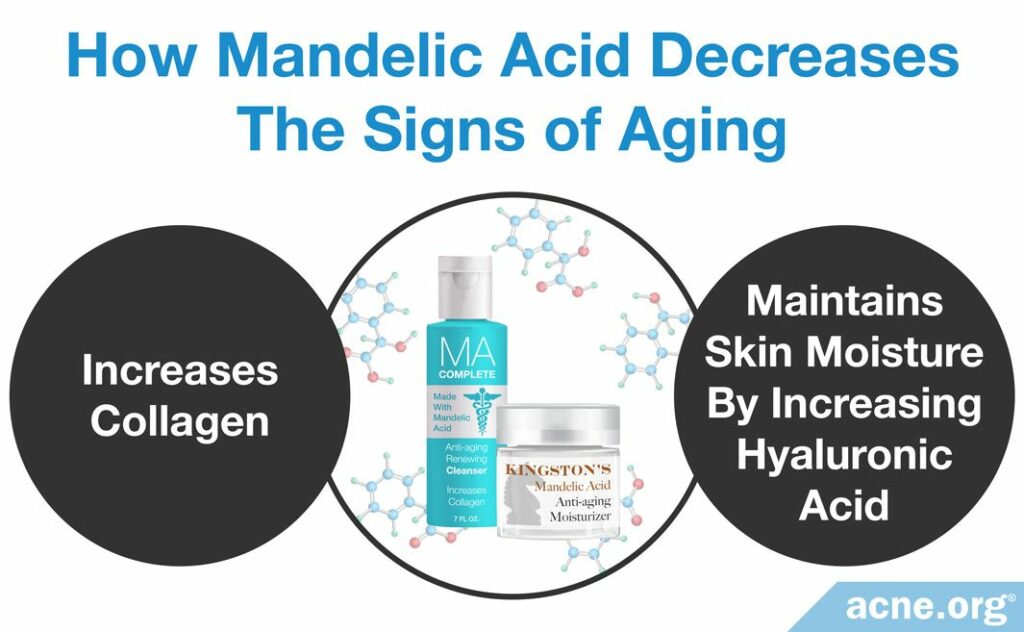
Mandelic acid has anti-aging properties, which means that it promotes:
- Skin thickening: In healthy skin, collagen provides support and structure to the skin. If this collagen is damaged, or if the amount of collagen decreases, wrinkles form. Mandelic acid can increase the amount of collagen, which helps the skin maintain its shape and strength.
- Skin hydration: Healthy skin must contain a certain amount of water, and without a proper level of moisture, the skin can become dry and flaky. This dryness can lead to skin damage and can make the skin look older. Mandelic acid works to maintain skin moisture by increasing the production of a compound called hyaluronic acid. Hyaluronic acid supports skin hydration, and the increase in moisture affects skin appearance, texture, and function.1,2
Mandelic Acid Side Effects
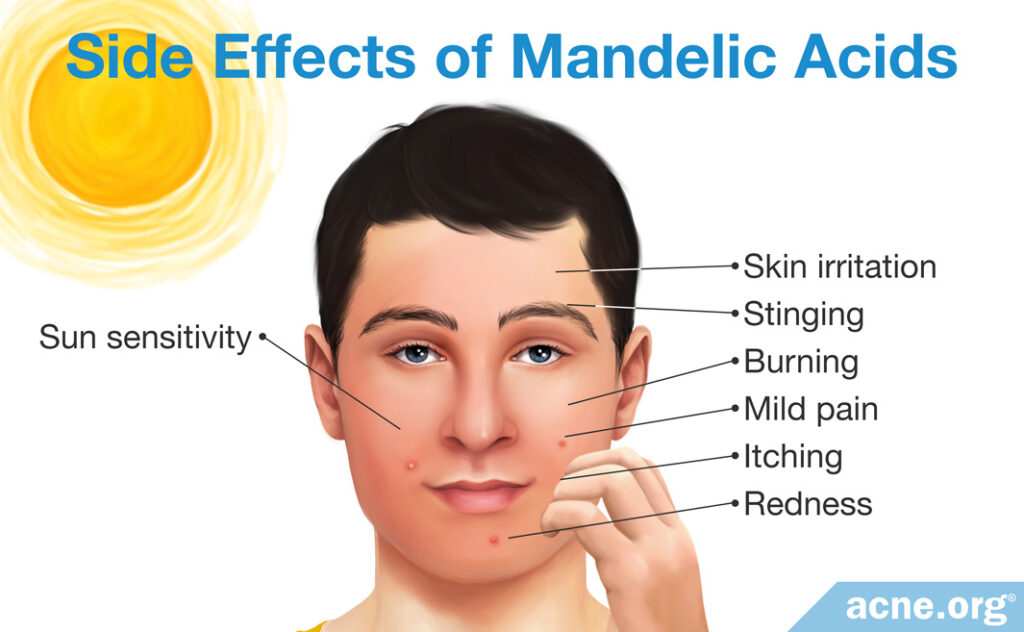
Mandelic acid is a strong acid compared to other AHAs, and normally this would mean that it has more side effects. However, the mandelic acid molecule is bigger than other AHA molecules, and this prevents it from penetrating as deeply into the skin. Since it cannot penetrate as deeply into the skin as other AHAs, it causes fewer side effects than other AHAs. The side effects of mandelic acid include:
- Skin irritation
- Burning
- Stinging
- Redness
- Itching
- Mild pain1,3
How Well Mandelic Acid Works on Acne
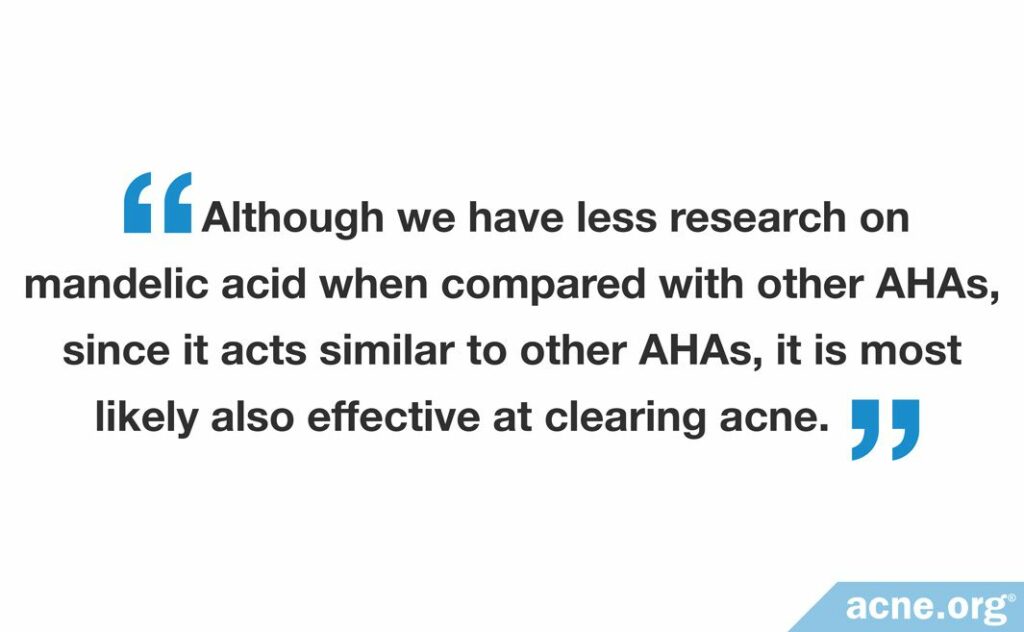
Researchers have performed a small number of studies investigating the effectiveness of mandelic acid by itself to treat acne, mandelic acid in combination with salicylic acid to treat acne, and mandelic acid to treat other conditions.
The little research available on mandelic acid and acne shows that it may be able to partially clear acne. Since mandelic acid is an AHA, it acts similarly to other AHAs, and is most effective at clearing acne when used in combination with acne medications like benzoyl peroxide. However, more research is needed before its effect on acne is definitively known.
Expand to read details on mandelic acid studies
Mandelic acid by itself to treat acne

A 2015 study published in the Polish medical journal Przeglad Dermatologiczny investigated the effect of mandelic acid to clear mild to moderate acne in 60 acne patients. As part of this study, participants applied either a 5% mandelic acid solution or a 10% mandelic acid solution daily for two months. The researchers found that the 5% mandelic acid solution resulted in a 60% reduction in the number of acne pustules, which are acne lesions that contain pus, while the 10% mandelic acid solution resulted in a 61% reduction in the number of acne pustules. Further, the researchers found that the 5% solution reduced the amount of sebum by 42%, while the 10% solution reduced the amount of sebum by 37%.4

A 2015 study published in the Journal of Dental and Medical Sciences investigated the effectiveness of a 30% mandelic acid peel to clear acne in 15 acne patients. In this study, the participants underwent six mandelic acid peels over the course of 12 weeks. The researchers found that the mandelic acid peels reduced acne by 54.7% on average, but one patient showed a 94.7% reduction in acne. Most patients reported moderate or good improvement of their acne.5

A 2020 study published in the Journal of Cosmetic Dermatology compared the efficacy of mandelic acid and salicylic acid for treating acne. The researchers looked at 50 patients with mild-to-moderate acne in India, whom they divided into two groups:
- Group 1 was treated with a 45% mandelic acid peel for 6 sessions over 12 weeks
- Group 2 was treated with a 30% salicylic acid peel for 6 sessions over 12 weeks
The researchers found that mandelic acid was better at treating inflammatory acne lesions, while salicylic acid was more effective against non-inflammatory lesions. However, overall, both peels were similarly effective at treating mild-to-moderate acne. In addition, the mandelic acid peel caused fewer side effects than the salicylic acid peel.6
Mandelic acid in combination with salicylic acid

A 2009 study published in Dermatologic Surgery studied the effectiveness of 10% mandelic acid in combination with 20% salicylic acid to treat acne. Salicylic acid is a beta hydroxy acid (BHA), which is also a hydroxy acid but differs from AHAs in how it impacts the skin. Salicylic acid is a common treatment for acne. Researchers performed this study by administering a chemical peel every two weeks for a total of five peels in 44 acne patients. The researchers concluded that the 10% mandelic acid/20% salicylic acid peel was effective at reducing the number of acne lesions by 52% and hyperpigmentation.3

Another study published in the Journal of Cutaneous and Aesthetic Surgery in 2019 compared the efficacy of several chemical peels, one of which was a combination peel containing mandelic acid. Forty-five patients of Southeast Asian background with mild-to-moderate acne participated in the study. The researchers divided the patients into 3 groups:
1. Group 1 received a combination peel containing 20% salicylic acid and 10% mandelic acid
2. Group 2 received a 35% glycolic acid chemical peel
3. Group 3 received a phytic acid peel
Each group received peel treatments every two weeks for a total of six treatments. At the end of the study, each group experienced an improvement in acne:
- In Group 1, acne improved by 74%
- In Group 2, acne improved by 71%
- In Group 3, acne improved by 70%
In other words, the salicylic acid-mandelic acid peel was slightly more effective at treating acne than the glycolic acid and phytic acid peels. The researchers wrote, “In this study, salicylic – mandelic acid peel group showed significant improvement in inflammatory acne lesions compared to the other two groups.”7

Lastly, a study published in the Journal of Cosmetic Dermatology in 2022 looked at the effectiveness of chemical peels containing 20% salicylic and 10% mandelic acid together with low-dose isotretinoin (Accutane®) for treating acne. The study included 58 adult patients with acne, who were divided into 2 groups:
- Group 1 received 0.5 mg/kg of oral isotretinoin once a day for 16 weeks.
- Group 2 received the same oral dose of isotretinoin, plus a chemical peelcontaining 20% salicylic acid and 10% mandelic acid every 4 weeks.
After 4 months, the researchers compared the acne improvement in the 2 groups to see whether adding the salicylic acid-mandelic acid chemical peel made a difference to the outcome. They found a greater decrease in acne severity in Group 2. In addition, 30% of patients in Group 2 achieved almost clear skin, and 10% of patients in Group 2 achieved clear skin, while no patients in Group 1 attained equally dramatic results. Therefore, the researchers concluded that adding a salicylic acid-mandelic acid peel to the isotretinoin treatment regimen improved the outcome. However, it is impossible to say how much of the credit belongs to mandelic acid specifically.8
Mandelic acid to treat other conditions

A 2013 study published in Advances in Dermatology and Allergology compared the effectiveness of a 40% mandelic acid peel to that of a 20% azelaic acid peel to reduce the signs of aging in 28 women. The researchers concluded that both acids were effective at reducing the effect of aging and dryness of the skin. However, they found that the mandelic acid increased the amount of sebum by 168.1% on the periphery of the face, which includes the temples, cheeks, and jaw. While increasing sebum is good for anti-aging, it is potentially detrimental to acne patients since increased sebum production can lead to more clogged pores and acne. However, this was only one small study, and the researchers did not state whether the elevated sebum levels were a long-term effect of the mandelic acid treatment. More research is needed before these findings can be confirmed.9

Similarly, a 2018 study published in Facial Plastic Surgery investigated the potential of mandelic acid to improve the quality of aging skin. Twenty-four patients between the ages of 42 and 68 years old applied mandelic acid to their faces twice a day for a total of 4 weeks. In the morning, the patients applied a serum containing 6% mandelic acid, while at night, they used a serum containing 4% mandelic acid. After 4 weeks of this regimen, the researchers measured the elasticity and firmness of the patients’ skin. They found that skin elasticity had increased by 25.4% over 4 weeks, while skin firmness had increased by 23.8%. Therefore, the scientists concluded that mandelic acid might be a useful topical treatment for improving the quality of aging skin.10
References
- Kontochristopoulos, G. & Platsidaki, E. Chemical peels in active acne and acne scars. Clin Dermatol 16, 1 – 10 (2016). https://www.ncbi.nlm.nih.gov/pubmed/28274356
- Taylor, M. Summary of mandelic acid for improvement of skin conditions. Cosmet Dermatol 12, 26 – 28 (1999). http://www.nucelle.com/pdf/article.pdf
- Garg, V. K., Sinha, S. & Sarkar, R. Glycolic acid peels versus salicylic-mandelic acid peels in active acne vulgaris. Dermatol Surg 35, 59 – 65 (2009). https://www.ncbi.nlm.nih.gov/pubmed/19076192
- Jakimiuk, E., Zielińska, J. & Kaszuba, A. Evaluation of the efficacy and tolerability of mandelic acid-containing cosmetic formulations for acne skin care zawierających kwas migdałowy u pacjentów z trądzikiem. Przegl Dermatol 102, 316 – 321 (2015). https://www.ncbi.nlm.nih.gov/pubmed/26859648
- Jartarkar, S. R., Mallikarjun, M., Gangadhar, B. & Manjunatha, P. Mandelic acid chemical peel in Acne vulgaris : A boon or a bane ? IOSR J Dent Med Sci 14, 32 – 35 (2015). http://www.iosrjournals.org/iosr-jdms/papers/Vol14-issue5/Version-7/I014573235.pdf
- Dayal, S., Kalra, K. D. & Sahu, P. Comparative study of efficacy and safety of 45% mandelic acid versus 30% salicylic acid peels in mild-to-moderate acne vulgaris. J Cosmet Dermatol 19, 393-399 (2020). https://www.ncbi.nlm.nih.gov/pubmed/31553119
- Sarkar, R., Ghunawat, S. & Garg, V. K. Comparative study of 35% glycolic acid, 20% salicylic-10% mandelic acid, and phytic acid combination peels in the treatment of active acne and postacne pigmentation. J Cutan Aesthet Surg 12, 158-163 (2019). https://www.ncbi.nlm.nih.gov/pubmed/31619887
- Dixit, N., Jena, A., Panda, M., Debasmita, B. & Ipsita, D. Randomized prospective study of low-dose isotretinoin alone and combination with salicylic acid and mandelic peel against acne tarda. J Cosmet Dermatol 21, 4398-4404 (2022). https://pubmed.ncbi.nlm.nih.gov/35388606/
- Wojcik, A., Kubiak, M. & Rotsztejn, H. Influence of azelaic and mandelic acid peels on sebum secretion in aging women. Postep Dermatologii i Alergol 30, 140 – 145 (2013). https://www.ncbi.nlm.nih.gov/pmc/articles/PMC3834725/
- Jacobs, S. W. & Culbertson, E. J. Effects of topical mandelic acid treatment on facial skin viscoelasticity. Facial Plast Surg 34, 651-656 (2018). https://pubmed.ncbi.nlm.nih.gov/30513536/
 Acne.org Products
Acne.org Products